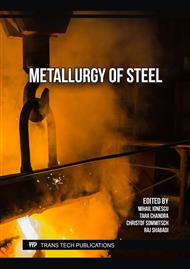p.61
p.81
p.87
p.93
p.99
p.105
p.111
p.117
p.123
Comparative Study of Quench and Partition Processes in High Si and High Al Steels
Abstract:
The quench and partition process is a means to develop third-generation high-strength steels using many possible process variants. In this work, two variants of quench and partitioning heat treatments, one-step and two-step, were carried out for high Si and high Al steel alloys. The kinetics of isothermal transformation occurring during the one-step quench and partition process were analysed using dilatometry. Experimental analysis revealed the swing-back phenomenon in high Si steel, and the transformation characteristics above and below the Ms temperature differed. The high Al alloy resulted in higher retained austenite (19%) compared to high Si steel (17%) during the one-step quench and partition process. Aluminium addition favoured bainite formation more than silicon addition. A comparison of two heat treatment variants shows the two-step quench and partition heat treatment seemed preferable as it produced more retained austenite (22%) in the high Si steel.
Info:
Periodical:
Pages:
99-104
Citation:
Online since:
November 2023
Authors:
Price:
Сopyright:
© 2023 Trans Tech Publications Ltd. All Rights Reserved
Share:
Citation:



